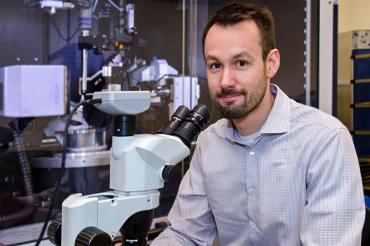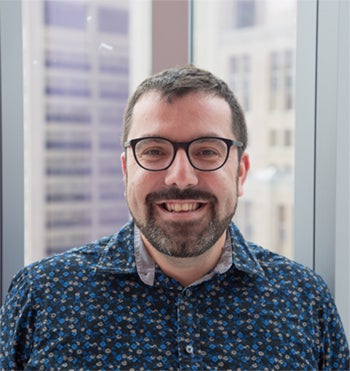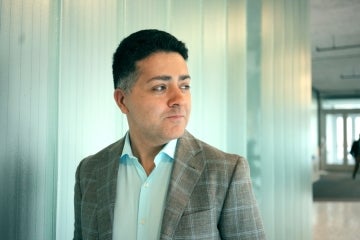How AI is enabling COVID-19 research

Published: July 17, 2020
In an age of COVID-19, the phrase “business as usual” has nearly lost all meaning for Canadians who have seen their lives disrupted in myriad ways.
That includes researchers Jean-Philippe Julien and Costin Antonescu as they work to find antiviral drugs that can fight the disease that is paralyzing countries around the world.
“Speed is the key,” says Julien, an associate professor in U of T’s departments of biochemistry and immunology and a senior scientist in molecular medicine at the Hospital for Sick Children who focuses his work on developing a vaccine for HIV and malaria. “That’s what is making research into COVID-19 different. We normally take a linear approach, going step by step, selecting a few candidate drugs or therapies and slowly moving them forward with testing over several years.
“But now, with COVID, we all understand that this approach is not possible. Everyone accepts that we have to move much faster.”
In an effort to speed the process, the pair are focused on determining whether existing drugs used to treat other diseases can be used to treat COVID-19 – and they are using artificial intelligence, or AI, to boost their work.
In particular, the pair is using a type of AI called machine learning, which relies on neural networks, modelled on the networks of neurons in the human brain, to learn and make decisions. The approach is being applied to everything from self-driving cars to new drug treatments – even which films and TV shows Netflix suggests you might like to watch.
Working through a local biotech company and drug development firm, Julien and Antonescu, a former U of T PhD student who is now an associate professor at Ryerson University, have used AI to identify existing drugs that may be effective against COVID-19. In particular, they have found molecules that may interrupt the virus’s ability to gain entry into cells and others that may limit respiratory distress.
The project is one of 14 being funded by CIFAR, a collaborative research organization that supported early work by U of T University Professor Emeritus Geoffrey Hinton, pioneer of deep-learning – a branch of machine learning that attempts to replicate how the human brain learns.
“COVID-19 has raised that possibility that our health-care system could potentially become overburdened, and that actions we have taken in response to this risk have brought about enormous economic, societal, and broader public health costs,” says University Professor Ted Sargent, U of T’s vice-president, research and innovation, and strategic initiatives. “This funding by CIFAR, which has a long history supporting AI research, will be key in helping researchers at U of T and other universities across Canada contribute to developing treatments.”
Elissa Strome, the associate vice president, research and executive director of the CIFAR Pan-Canadian AI Strategy, noted that interdisciplinary collaborations are critical to defeat the coronavirus and that CIFAR provides both the space and freedom for researchers to explore high-risk, high-reward ideas.
“The CIFAR AI and COVID-19 Catalyst Grants Program is mobilizing new ideas, products and services that have the potential to save lives around the world,” Strome says.
 Julien and Antonescu first met while earning their PhDs in biochemistry at U of T in the early 2000s and then worked at the same research institute again while doing post-doctoral work at Scripps Research near San Diego.
Julien and Antonescu first met while earning their PhDs in biochemistry at U of T in the early 2000s and then worked at the same research institute again while doing post-doctoral work at Scripps Research near San Diego.
They eventually returned to Toronto, with Antonescu landing at Ryerson, where he is an associate professor in the department of chemistry and biology and an affiliate scientist at St. Michael’s Hospital.
Antonescu normally focusses his work on breast cancer. A few years ago, he began working with Cyclica, a Toronto-based biotechnology company that specializes in using AI to develop drugs.
“So the work JP and I are doing now in using AI on COVID-19 began when my lab started working with Cyclica. We were using the results of Cyclica’s machine learning tools to develop and identify molecules that are predicted to have drug-like behaviour and to develop new cancer therapies.”
When COVID-19 began its assault on the world, Antonescu and Cyclica applied the same approach they were using for cancer to the novel coronavirus. They are now also working with an AI-powered drug-development company called Phoenox Pharma, a U of T-linked startup.
“That’s when the collaboration with JP and his lab became invaluable,” says Antonescu. “He’s developing a number of assays to measure the virus and treat it. We all saw a prime opportunity to get together and use the AI expertise from Cyclica and JP’s scientific knowledge that he has amassed through his work on HIV and malaria.”
Julien, who is also Canada Research Chair in Structural Immunology, agrees that the team’s existing work enabled them to tackle COVID-19 quickly and effectively.
“We had all those years together,” he says. “That collegiality allowed us to come together rapidly. Costin reached out to me on a Wednesday and then the grant proposal to CIFAR went in on a Friday. There’s trust and respect for each other that’s there and that allows you to build fast.”
Both Julien and Antonescu have a wealth of experience in understanding how pathogens – bacteria, fungi, parasites and viruses that cause disease – invade our cells.
“Cells would love to put up an impenetrable wall and not let any invaders in, but then they would face the problem of not being able to take up nutrients and communicate with one another, which prevents hormones from working,” says Antonescu. “So the surface of a cell has to walk a fine line between communication and protection. Viruses wind up being able to hijack some of the normal mechanisms that cells use to interact with their environment.”
“Pathogens and their ability to invade is an important theme,” adds Julien. “In my field, a virus like HIV targets immune cells and depletes your immune system. Bacteria through toxins they secrete can hijack cell receptors in the lungs or other tissues. And that’s what SARS COV-2 is doing – invading cells – and that results in this new disease called COVID-19. The job now is to develop anti-viral drugs that can block that invasion.”
Julien and Antonescu will feed new information they discover from their experiments back to their AI collaborators at Cyclica and Phoenox who will predict more molecules worth testing. Within four months, the team hopes to identify candidate drugs that work to stop “pseudoviruses” in cells and that can move forward to the next stages of testing: live viruses and animal models.
“The benefit of the AI is that it can do so much more than we can do in our labs,” says Antonescu. “In a normal assay, you can screen 100,000 compounds. With more funding, we could go up to 500,000. But AI companies like Cyclica and Phoenox can sample 10 million compounds with their technology. They won’t come up with a guaranteed silver bullet, but they will be able to narrow it down to a couple hundred. That is really helpful. And then JP and I will come back in and do the biological assays, testing and rapid progression into something you hope can be used to treat patients.”
The powerful benefit of AI to researchers such as Julien, Antonescu and the other CIFAR recipients is part of a wave of AI that is boosting Canada in many ways.
A new report, prepared by U of T with data compiled by Ottawa’s Global Advantage Consulting Group, found that Canada’s unique combination of public investment, private capital, research capacity and talent has generated over 50,000 jobs and attracted nearly $3 billion in investment since 2010.
The report, entitled Canada’s AI Ecosystem: Government Investment Propels Private Sector Growth, notes that the number of active AI start-up companies in Canada has doubled to more than 670 since 2015, with U of T alone producing 81 active startups. In total, AI-powered startups have raised $183 million in funding and created more than 600 jobs in the past five years.
Read more about the report
Of particular note is the impact of the Vector Institute for Artificial Intelligence – launched three years ago with $50 million in support from the government of Ontario and another $80 million from industry partners – and how it has connected U of T and partner hospital research with the business community to spur innovation. Added to this is CIFAR, which has played a key role in the federal government’s Pan-Canadian AI Strategy.
That kind of collaboration – between universities, hospitals, agencies, industry and government – is essential now, notes Julien, as the global research community comes together to find solutions to COVID-19.
It’s all hands on deck,” he says. “All kinds of different funders – governments, granting agencies, private industry and philanthropists. And scientists in so many disciplines. We’re throwing everything at this problem.”
Both Julien and Antonescu emphasize that the progress that will be made on this global assault on the virus comes from two avenues of research – technology and fundamental knowledge.
“The new technologies that are emerging out of this will be extremely useful for the next pandemic,” says Julien. “But for this current crisis, the technology available to us now is so much more powerful than what we would have had in the past. A couple of decades ago, we didn’t have the technological infrastructure that we have today.
These U of T-affiliated researchers are working on projects supported by CIFAR’s AI and COVID-19 Catalyst Grants initiative. (You can see more information about the projects and their collaborators here.)
AI-Driven Identification and Validation of Drug Repurposing Candidates to Treat COVID-19
Jean-Philippe Julien of the department of biochemistry in the Faculty of Medicine; CIFAR fellow; Molecular Architecture of Life program; Hospital for Sick Children
MyTrace / MaTrace: A Privacy-Compliant Contact-Tracing Mobile App for COVID-19
Alán Aspuru-Guzik of the department of chemistry and the department of computer science in the Faculty of Arts & Science; Canada CIFAR AI Chair; CIFAR fellow; Bio-Inspired Solar Energy program; Vector Institute
Marzyeh Ghassemi of the department of computer science in the Faculty of Arts & Science and the department of medicine in the Faculty of Medicine; Canada CIFAR AI Chair; Vector Institute
PanXcea: PANdemic Prediction with X-ray-based COVID-19 External Analysis
Marzyeh Ghassemi of the department of computer science in the Faculty of Arts & Science and the department of medicine in the Faculty of Medicine; Canada CIFAR AI Chair; Vector Institute
Chris McIntosh of the department of medical biophysics in the Faculty of Medicine
Preventing COVID-19 Infection in Families: The COVID-19 Child and Family Study
Jonathan Maguire of the Institute of Health Policy, Management and Evaluation at the Dalla Lana School of Public Health; Hospital for Sick Children
Anna Goldenberg of the department of computer science in the Faculty of Arts & Science; Canada CIFAR AI Chair and CIFAR fellow; Child and Brain Development program; Vector Institute; Hospital for Sick Children
Marzyeh Ghassemi of the department of computer science in the Faculty of Arts & Science and the department of medicine in the Faculty of Medicine; Canada CIFAR AI Chair; Vector Institute
Catherine Birken of the department of paediatrics in the Faculty of Medicine; Hospital for Sick Children
Peter Jüni of the Institute of Health Policy, Management and Evaluation at the Dalla Lana School of Public Health; St. Michael’s Hospital
Kevin Thorpe of the biostatistics division at the Dalla Lana School of Public Health; Sunnybrook Hospital
Charles Keown-Stoneman of the biostatistics division at the Dalla Lana School of Public Health; Sunnybrook Hospital
Rapid, Automated Assembly of SARS-CoV-2 Phylogenies
Quaid Morris of the Terrence Donnelly Centre for Cellular & Biomolecular Research in the Faculty of Medicine; Canada CIFAR AI Chair; Vector Institute
Jeff Wintersinger of the department of molecular genetics in the Faculty of Medicine
Jeff Wrana of the department of molecular genetics in the Faculty of Medicine; Lunenfeld-Tanenbaum Research Institute
Benjamin Blencowe of the Terrence Donnelly Centre for Cellular & Biomolecular Research in the Faculty of Medicine



